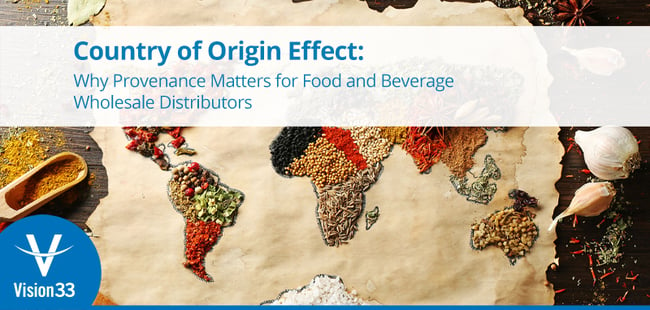For shoppers it’s important to know where our food comes from to make informed decisions, country of origin can signal quality; supporting faster decision making, and serve as a competitive advantage against competitor foodstuffs whose origin is not clear. Read the article.
 Empowered by access to information, modern consumers are becoming increasingly selective about the provenance of foodstuffs of food and beverage companies. For the growing number of shoppers who believe it’s important to know where our food comes from to make informed decisions, country of origin can signal quality; supporting faster decision making, and serve as a competitive advantage against competitor foodstuffs whose origin is not clear.
Empowered by access to information, modern consumers are becoming increasingly selective about the provenance of foodstuffs of food and beverage companies. For the growing number of shoppers who believe it’s important to know where our food comes from to make informed decisions, country of origin can signal quality; supporting faster decision making, and serve as a competitive advantage against competitor foodstuffs whose origin is not clear.
Country of origin labelling can have a considerable influence on consumers’ perception and purchasing decisions. Consumers who are concerned about human and animal rights or environmental impact look to country of origin to ensure their purchase supports economies where higher welfare standards prevail. For other consumers, interest in knowing food’s country of origin may relate to a desire to reduce the carbon footprint by buying produce that isn’t shipped from far away. For others, it may be about the desire to support local or national economies, or a belief that domestic brands are more trustworthy and better attuned to consumers’ needs or tastes.
Country of origin is also sometimes used as a proxy measure for quality and safety standards, where certain practices, pesticides or fertilisers are used (or not used) in a country or region. In 2017 there was backlash in the UK against importing US chicken washed in chlorine as part of a post-Brexit transatlantic trade deal, while chlorination is currently prohibited in the EU.
For other consumer sub-cultures such as the foodies, country of origin has more to do with place-based branding and protected designations of origin providing assurances around distinctive local goods. Certain products have a specific quality or characteristics that are due to the geographical environment or local tradition in which they’ve produced, such as Champagne, Roquefort, Chianti and Darjeeling.
Fact from Fiction
Complicating matters for consumers is that country of origin labelling on food products has become a somewhat controversial topic in recent years amid “fake foods” scandals. In 2015, Italian extra-virgin olive oil flooding the world’s market shelved was neither Italian nor extra-virgin – or even olive oil in some cases. In 2017 a well-known UK grocery retailer came under fire for using controversial “fake farm” names on its own-brand produce and meat, when in fact, some of these products were not even sourced in the UK but imported from overseas.
It’s not only supermarkets capitalising on deception. Under an EU labelling loophole, UK retailers – including farm shops and local butchers – are entitled to call a meat product ‘British’, even if the meat itself is sourced from abroad if the product has been processed and packed in the UK. It’s not unusual to see ‘Wiltshire’ cured ham that, on closer scrutiny of the label, is made from EU pork – and it can even bear a union flag on the packaging.
What these examples illustrate is a growing demand by consumers for food provenance transparency. For food and beverage manufacturers and distributors, it is an opportunity to offer greater value than the competition to consumers that are navigating false claims in the marketplace.
Food Traceability As a Competitive Advantage
Country of origin is not a guarantee of food safety: 2013’s horse meat scandal illustrated that if you believe you’re buying a beef lasagne, horse meat is horse meat, regardless of where it comes from. Nor does country of origin provide any real certainty about the way livestock has been reared, slaughtered, processed, or packaged.
However, country of origin is an important component in food traceability – the ability to track any foodstuff, feed, or food-producing animal through all stages of production, processing and distribution. But with globalisation, products often traverse complex global supply chains to reach consumers, making traceability a technical, logistical, and financial challenge.
Some countries have introduced legal reform, such as the U.S. FDA Country of Origin Labelling (COOL), which mandates specific labelling practices for several “covered commodities”. But private sector traceability initiatives and voluntary quality assurance systems are also emerging, often because of pressure from downstream food retailers, motivated by a justifiable desire to reduce their own risk exposure.
For both distributors and manufacturers, the ability to reliably select products based on country of origin can be a distinct competitive advantage. For example, a company making authentic passata will specify Italian tomatoes in its recipe, rather than Spanish. Or a Mediterranean supermarket may have a strict requirement for apricots grown in Turkey rather than France or Algeria.
A Batch of Reasons to Capture Data
Whether meeting regulations or requirements, an effective traceability system is essential to solve the country of origin conundrum. A modern, food traceability system should enable every single pallet, case or item to tell its story wherever it goes, at any point in the supply chain – not just provide the bare minimum of ‘one step back, one step forward’ visibility.
Batch attributes are a standard feature supported by Vision33’s ERP solution for Food and Beverage Manufacturers/Distributors. Attributes such as country of origin, GM status, and farm, can be used to provide documented evidence to customers and supply chain partners. Users can use RF mobile devices to easily capture a purchased product’s country of origin receipt, recorded at the item batch or lot level. This data is available from the point of receipt, through one or more production activities, packaging, movement through the warehouse, or as part of each shipment to the customer.
In the digital era, traceability of origin is highly feasible using an industry focused solution such as Vision33’s ERP solution for Food and Beverage Manufacturers/Distributors, offering an opportunity for progressive food industry enterprises to position their businesses at the forefront of the market. To understand more about how Vision33’s ERP solution for Food and Beverage Manufacturers/Distributors supports country of origin read this product solution brief.


